Hot Indian Bike Bazaar in 2007, 60 New Models Coming
New Bikes India 2007 Pulsar 220 Bajaj
New brands will also be entering the market next year with Chinese firms firming up launch plans as well as several electric bike makers set to go full throttle. The Guangzhou Motor Company recently signed a technology partnership pact with Kolkata-based Xenitis Group to launch its bikes in India early next year. Another Chinese motorcycle manufacturer Zongshen Motorcycle Company has tied up with the Salim Group for its two-wheeler project in West Bengal. These Chinese bikes are sure to give sleepless nights to Indian manufacturers on the pricing front however it will be difficult for them to match with the large service network of the Indian counterparts.
Further, electric bike makers including Hero Group/Ultra Motors and Electrotherm are set to sell their products from next year. According to analysts, with margins at the entry-level (100 cc segment) segment being wafer-thin, most of the new launches are likely to be in the higher engine capacity segments. The Bajaj Pulsar 220 being a perfect example of this.
003 CHROMED CHOPPER Category: Bikes -SOLD- Unit Price: $55000.00
PATRICK RACING 138CI KECK ENGINE
TYPHOON CARBURETOR
HOTMATCH PIPES
NESS PRIMARY
BARNETT CLUTCH
BAKER 5 SPEED TRANY
PM HANDLE BAR CTR MOLDING WITH THE BAR
PM FORWARD CTR
PM CALIPERS
FRONT END SPRINGER ONE MADE BRAKE LINES INCORPORATED
ELECTRONIC BOX WITH SECURE CODE
HANDMADE GASTANK
THIS BIKE HAD 1500 MILES. SPENT $85000.00 TO BUILD IT AND JUST SPENT ANOTHER $6000.00 TO DO SOME CHANGES
My CB 750 Custom Chopper Project
To make things shorter I rented a van and drove 4,000 miles back and forward to get the thing.
It fired after two kicks, needed a tune up (which no shop around here dared to attempt, so I really studied hard and did it myself...getting the jets alone was hellish).
After the excitement of getting a cool cheap ride vanished, I realized I could change a few things here and there. So after 3 years I have changed the front end (It´s a hardtail, and the forks didn´t had that much compression, even though I changed the oil), made an oil tank out of a 5" pipe, made a V bar with a friend´s welding skill´s help, and made an internal throttle which I haven´t finished yet.
Well, it still has many things undone. It is not a Harley, but I have an efficient machine (the thing is almost 30 years old, it hasn´t been touched yet, and compression is still good!)
It's a cool ride for a lot less that the Harley dealer asked for, and a whole a lot less than the 10,000 US dollars that a chopper shop asked for a rebuild.
Honda launch new clothing range
Released in honda's 50th year of motorcycle racing, the new range includes a Pit Shirt, Hi-Neck Long Sleeve Rider's Tee, Winter Jacket, Men's and Ladies Polo's, Puffa Vest and a lighter weight jacket with inner fleece – the 'Performance Jacket'.
Part of the inspiration behind the 'Team honda' range was to offer customers a brand new range of merchandise that embodied honda's overall racing efforts rather than a specific race team.
Every detail of the 'Team honda' range, from the packaging to the design, embodies true honda quality.
The designs feature race logos as well as grey and red detailing. The garments are available in a wide range of sizes.
The Ladies and Men's Polo and the Hi-Neck Long Sleeve Riders Tee retail for $60, the Pit Shirt and Puffa Vest retail for $85, the Performance Jacket retails for $160 and the Winter Jacket retails for $220.
'Team honda' racewear is now available from honda Dealers nationwide.
honda racewear
Yamaha Gladiator Type SS / RS
Yamaha FZ (150)
IMO The best looking among the 3, the Yamaha FZ is a mean-looking naked street bike, again made for India inheriting from the European FZ1. FZ will share R15’s 150cc single cylinder engine but will be air-cooled, no further specs available right now. Yamaha FZ 150 will to be launched in India by November 2008.
Yamaha YZF-R15
DUCATI 1198 S – HEAVY WEIGHT SUPER SPORTS BIKE
The Ducati 1198 S falls under the heavy weight segment of Super Sports Bikes Category. The S model of its comes with high power and overwhelming torque, the 1198cc Testastreeta Evoluzion engine produces a very powerful 170bhp of torque @ class-beating 8,000rpm. The crankcase is build up by the vacuum die-cast tech due to which the engine is almost 3kg lighter and contributes to a dry weight of an amazing 169 kg. The 0-60 mph is less than 2.5 sec and the top speed is estimated at 186 mph (299km/h). An addition to the 1198 S, Ducat’s production house has integrated a true competition-level Traction Control System (DTC). The Ducati Traction Control System can be adjusted by the Rider from the left hand switchgear, the ultra hi-speed software of the system offers a choice of 8 settings developed by Ducati’s Riders and Racer’s. To be in full control and easy hi-speed menuvering a 7-spoke GP Marchesini forged and machined wheels are matched with fully adjustable hi-perfoThe Ducati 1198 S falls under the heavy weight segment of Super Sports Bikes Category. The S model of its comes with high power and overwhelming torque, the 1198cc Testastreeta Evoluzion engine produces a very powerful 170bhp of torque @ class-beating 8,000rpm. The crankcase is build up by the vacuum die-cast tech due to which the engine is almost 3kg lighter and contributes to a dry weight of an amazing 169 kg. The 0-60 mph is less than 2.5 sec and the top speed is estimated at 186 mph (299km/h). An addition to the 1198 S, Ducat’s production house has integrated a true competition-level Traction Control System (DTC). The Ducati Traction Control System can be adjusted by the Rider from the left hand switchgear, the ultra hi-speed software of the system offers a choice of 8 settings developed by Ducati’s Riders and Racer’s. To be in full control and easy hi-speed menuvering a 7-spoke GP Marchesini forged and machined wheels are matched with fully adjustable hi-performance Ohlins forks, shock and steering damper. All these features gives the Ducati 1198 S the highest torque-to-weight ratio of any high performance super sports bike ever in autooutlet world.
Engine Type : l-twin cylinder, 4 valve per cylinder Desmodromic, liquid cooled
Displacement 1,198.4cc (73.1cu in)
Power : 126.8 kw (170.0bhp) @ 9750rpm
Torque : 97.0 ft·lbf (132 N·m) @ 8000 rpm
Frame : Tubular steel Trellis frame in ALS 450
Wheelbase : 1,430 mm (56.3 in)
Front suspension : Ohlins 43mm (1.7 in) fully adjustable upside-down fork with TiN
Rear suspension : Progressive linkage with fully adjustable Ohlins TTXR mono shock with top-out spring. Aluminum single-sided swing arm
Exhaust : Light weight 2-1-2 system with catalytic converter and 2 lambda probes. Twin stainless steel and titanium mufflers.
Primary drive : Straight cut gears, Ratio 1.84:1
Final drive : Chain; Front sprocket 15; Rear sprocket 38
Gearbox : 6 speed
Emissions : Euro 3
Price :US $ 21,795
One Response to “DUCATI 1198 S – HEAVY WEIGHT SUPER SPORTS BIKE”
Tokyo Motor Show: Two-Wheel Thunderdome
TOKYO — Although most of the media focus at the 40th Tokyo Motor Show is on the three convention halls stuffed with the latest four-wheel dream machines, Tokyo is the only major auto show that also showcases motorcycles. They’re over in a pulsating big top tent officially called the North Hall, but for bikers, it should be called Fantasyland — something on the order of “Blade Runner” meets the mechanical bull scene in “Urban Cowboy.”
Besides the eyeball-assaulting light show, music loud enough to make your ears bleed and models in go-go boots and vinyl minidresses, there is a full spectrum of new rides, from futuristic to retro.
Let’s start at the Honda booth, where on one side, it’s back to the future, and on the other, Jimmy Carter is president again: the CB1100F, to me, evokes great old Hondas like the CBX, albeit with fewer exhaust pipes. Others will see what they want to see, but either way, it’s a beaut. The CB1100R (R for race) is about as ’70s as shag carpet, monaural LPs and polyester pants. Great retro themes overall though, and certainly buildable.
Muscle Bike Party: the Honda EVO6 has some really outer-galaxy styling and it’s coupled with a smart use of Honda’s underutilized six-cylinder engine from the Gold Wing. Output in this format would be more than the Gold Wing’s 118 horsepower. It looks like the styling department, however, ran out of time before they got to the rear of the bike.
The Suzukis are wild. Silent runner: the Crosscage is a fuel cell bike that really works; no gas engine at all. The powerplant is made by Intelligent Energy of the U.K., the same group that made the ENV fuel cell bike I tested — and thought was viable even if it sounded like a U.F.O., not a bike. The Biplane supposedly has a V-4, but the show bike is most likely a make-believe mockup. Looks to be straight out of a video game. When will either Suzuki be produced? Right after the 12th of Never.
Yamaha’s Tesseract looks like it wound up on the cutting room floor from the “Transformers” movie. It has another one of those dreamweaver hybrid powerplants; the jury is out whether it would even be classified as a motorcycle. Would it look quite as cool with air bags, seatbelts and impact-resistant bumpers? I don’t think so. It’s kind of a grown-up version of one of those scooters for the “help-I’ve-fallen-and-can’t-get-up crowd.” Perfect for cruising supermarket aisles. A lot of showgoers cooed over the retro-classic Yamaha Sakura. A standard-style bike with an 1,100cc V-twin would generate a lot of showroom traffic, methinks.
Finally, at the Kawasaki stand, the Z1000 gets a new suspension layout that helps improve engine and exhaust placement; that, in turn, permitted some low- and mid-range performance gains. KZ also says this screamer has better suspension components and brakes. But the leaner, meaner ZX10R is the more significant new intro, now with 170-175 horsepower, thanks to dual fuel injectors on each cylinder. Compression ratio is up to — yikes — 12.7:1. Stand back when you fire that puppy up.
The Ninja ZX-14 had to be massaged to meet tighter emissions standards, especially in Europe, so Kawasaki engineers thought, “Why not ratchet up that engine output while we’re at it?” Horsepower was already an unpublished number, but now, figure it has been bumped north of 180 at the rear wheel, 200 or more at the crankshaft. Last but far from least: A new 2-into-1 exhaust on the Ninja 250R perks up the engine; a new full fairing perks up its looks.
Important Note: Kawasaki was showing bikes they will produce; the competitors were showing daydreams they (and we) wish they could.
Thunder Struck makes cusom bikes?
Thunder Struck Customs makes some sleek and sexy bikes, but the one that really caught my eye was this one, called the Hammer. Featuring a 147 cubic inch motor, six speed transmission, and style that borrows from Ferraris, AC Cobras, concept cars and drag bikes, it definitely put Thuder Struck’s Medford, Oregon shop on the map.
Tomahawk: The World’s fastest bike!
Well, there is a reason I did not go out of my way and call it the fastest two wheeler on turf and that is quite simple because it ain’t one. The Tomahawk is still a bike but it seems to have four wheels under it. To carry this super heavy weight among the bikes that is pretty much a requirement. But that does not take away an iota of style or sheer intimidating appearance that the Tomahawk carries. This is pretty much the “Iron Mike’ among the bikes and is designed to deliver that early second round knock out. That does not mean that there is nothing pretty about this machine.
The Tomahawk is a Viper V-10 based motorcycle, a 500 horsepower engine with four wheels beneath it. Chrysler will be selling the original Tomahawk concept and nine replicas through Neiman Marcus, for up to $555,000 each. A Chrysler spokesman told Reuters they were meant as rolling sculptures. Rumors had the Tomahawk would be selling for under $200,000, most likely at a loss or break-even price, for publicity purposes - but still fully drivable. Wolfgang Bernhard, Chrysler’s not particularly respected first mate, was said to be enthusiastic about that project, so much so that hundreds were projected to be built at under $200,000 each. They reportedly cost Chrysler over $100,000 to build.
This super heavy weight is crafted to intimidate and destroy all competition. That does not mean that you can carry this on to the road as you would never be able to obtain a license for it. So they are nothing but rolling sculptures and that is a heavy price to pay for something that you can’t take out and flaunt. The bike, if needed to run, runs on 93 octane unleaded premium and has a 10-cylinder V-type engine. Reminds me so much of the days when I started to play ‘RoadRash’. Now this piece of automobile mastery is not for all and is not designed for daily use obviously. But if you want to just take a look at this super monster then you can visit the nearest auto show sporting it. With a top speed of well over 350 mph, this thing will blur everything around!
Suzuki Hayabusa & Intruder Press Release
The Legends Have Arrived
Suzuki’s two most sought after bikes Hayabusa and INTRUDER launched in India.
The roads will wonder who passed by. Get ready to renew your faith in the physics of design. The two most renowned, four stroke, liquid cooled massive demons of power, steel and style are ready to burn the Indian roads with digital fuel injection and the most enviable wave of tractable power and responsive torque.
Suzuki Motorcycle India Pvt. Ltd., a subsidiary of one of the world’s leading two-wheeler manufacturers Suzuki Motor Corporation, Japan, bowled the Indian bike freaks with the launch of its most awaited bikes, Hayabusa and INTRUDER M1800R.
Celebrated as the pioneers and leaders in the field of land crusader manufacturing, Suzuki has again proved its metal in the Indian market one more time with this launch. The entire focus of the launch was to deliver dazzling technology and performance to exhibit that they have now raised the bar in the motorcycle industry with superior technology and innovation.
These bikes have been reigning the international market for long were desperately seek in India. Both Hayabusa and INTRUDER are seen as ultimate machines and are known for their powerful engines and style. Launch of both the bikes in each other’s company unanimously was thrilling and electrifying.
Acknowledged as the legend in the league of sports bikes, Hayabusa is so unique that it requires its own new classification: Ultimate Sport. This motorcycle is so exciting that is has developed a devoted following around the world. It combines seemingly effortless acceleration, wind-cheating aerodynamics, sporty handling, timeless style, long distance comfort and unlimited excitement.
The machine has a muscular four- stroke, four cylinder and liquid-cooled DOHC engine. It has an overhauled oil capacity of 4.0L, fully transistorized ignition and radial mount breaks in the front. The bike sports the new advanced digital fuel injection system with three way selectable engine mapping to suit personal preferences.
The Hayabusa’s instrument cluster features a set of four analog gauges, including step-motor—driven tachometer and speedometer, fuel meter and coolant temperature meter. It comes with wind-cheating, wind-tunnel-developed aerodynamic shape, and the giant weights 220kg.
Hayabusa is likely to be seen in four titillating colours; Solid Black / Metallic Majestic Gold and Pearl Nebular Black / Metallic Phantom Gray.
Introducing to the Indian market, a new level of excitement on the roads, INTRUDER M1800R is a style statement in itself. One look is all it takes to tell that INTRUDER M1800R is not an average cruiser. The most striking feature of this model is an all-new 1783cc, v-twin engine, liquid cooled with DOHC and digital fuel injection. Presenting to you the new classic look with an engine designed to produce a massive wave of tractable power and responsive torque starting just off idle and reaching to redline. The bike has an unmatched combination of the latest high-performance technology and a unique, exciting style.
Suzuki Hayabusa (2008-2009)
Two Brothers Racing M-2 Complete Exhaust Systems - Suzuki Hayabusa (2008-2009)
2008 Suzuki Hayabusa V.A.L.E.™ Full Exhaust Systems: Install a new Two Brothers Racing exhaust system and get ready to tear up the pavement.
The all new redesigned TBR complete system for the new Hayabusa provides unsurpassed craftsmanship and improved performance. These are just a few of the benefits that you gain by adding one of the all new M-2 complete exhaust systems to your bike. By reducing the weight improving the horsepower and torque, our new full system for the new Hayabusa is exactly what you need for unlocking all that your new Hayabusa has to offer.
The entire line of M Series canisters feature the same high level of quality construction and are designed to be fully serviceable in the event of damage (replacement parts are available, please call us), routine maintenance or the occasional repack. Two Brothers Racing’s M series spring-mounted slip-on canisters all feature our patented and exclusive lightweight thinwall die cast aluminum one-piece inlets and outlets. Our V.A.L.E. (patent pending) slip-on exhaust systems and flange-on systems feature CNC'ed aluminum inlets. These special designs provide for ease of maintenance as well as simplified construction, which is what a premium performance product is all about! The exhaust note produced by all of our Top Level exhaust systems is best described as being deep and throaty without suffering from the shrill whine normally associated with other manufacturer's straight through muffler canisters.
- Our exclusive V.A.L.E.TM mounting system eliminates the need for springs resulting a more secure mounting. Our exhaust systems are lighter than stock and deliver higher performance for your Suzuki Hayabusa .
- Specially designed and fitted for the Hayabusa , this Two Brothers Racing high performance exhaust system will help you gain additional horsepower while lowering the weight of your bike.
- Our brand new M-2 V.A.L.E.™ exhaust system features our exclusive Teflon coated, blunted, cast magnesium outlet that not only looks great but also allows for various silencer inserts.
- The V.A.L.E.™ inlet design eliminates the use of springs and creates an adjustable mount that is solid when fixed in place.
- The system also features a thinwall s-bend tube that connects to the factory header pipes.
Two Brothers Racing M-2 Complete Exhaust Systems - Suzuki Hayabusa (2008-2009)
2008 Suzuki Hayabusa V.A.L.E.™ Full Exhaust Systems: Install a new Two Brothers Racing exhaust system and get ready to tear up the pavement.
The all new redesigned TBR complete system for the new Hayabusa provides unsurpassed craftsmanship and improved performance. These are just a few of the benefits that you gain by adding one of the all new M-2 complete exhaust systems to your bike. By reducing the weight improving the horsepower and torque, our new full system for the new Hayabusa is exactly what you need for unlocking all that your new Hayabusa has to offer.The entire line of M Series canisters feature the same high level of quality construction and are designed to be fully serviceable in the event of damage (replacement parts are available, please call us), routine maintenance or the occasional repack. Two Brothers Racing’s M series spring-mounted slip-on canisters all feature our patented and exclusive lightweight thinwall die cast aluminum one-piece inlets and outlets. Our V.A.L.E. (patent pending) slip-on exhaust systems and flange-on systems feature CNC'ed aluminum inlets. These special designs provide for ease of maintenance as well as simplified construction, which is what a premium performance product is all about! The exhaust note produced by all of our Top Level exhaust systems is best described as being deep and throaty without suffering from the shrill whine normally associated with other manufacturer's straight through muffler canisters.
- Our exclusive V.A.L.E.TM mounting system eliminates the need for springs resulting a more secure mounting. Our exhaust systems are lighter than stock and deliver higher performance for your Suzuki Hayabusa .
SEMA 2008: AEM Carbon Fiber Hayabusa Motorcycle
Not only were there carbon fiber cars like the 350Z, but we also caught a full carbon motorcycle. Feast your eyes on this all carbon fiber Suzuki Hayabusa that was located at the AEM booth:
I believe the engine management system was done by AEM, but am unsure about what other modifications were done.
Also shown with the bike was a full carbon fiber helmet, a nicely added touch:
2003 Suzuki Hayabusa - Tripl3 Threat
Tired of losing his cookie-cutter 2003 Suzuki Hayabusa in a sea of similar rides, Nick Dagostino added a third wheel to set his off. Now he has no problems finding his bike–it’s the one with the crowd gathered around it!
If “dare to be different” is the custom bike builder’s credo, then why the heck do so many custom sportbikes look exactly the same? The motivation for customizing your motorcycle is typically to create something unique and original, unlike what anyone else is riding, so you stand out at the local bike night. What to do, then, after you drop more than $10K on chrome and aftermarket exhausts and extended swingarms to individualize your ride only to find your “unique” vision is shared with nearly every other sportbiker on the street?
That was the situation Nick Dagostino found himself in last summer after he finished up the first round of customization on his 2003 Suzuki Hayabusa. “I did all the usual stuff,” the Saratoga Springs, New York, resident told us. “Chromed the gas tank, polished everything else, lowered the bike, stretched it 7 inches, but everywhere I went out here I saw 10 more that looked exactly like mine! I hate being in the mainstream; I always want to have something different from the rest. So I went home one night and, halfway into a 12-pack, I thought, ‘What the hell can I do that no one’s ever done before?’ This is what I came up with.”
“This,” of course, refers to the wild tandem swingarm mounted on his Hayabusa, which hangs a third wheel off the aft end of the bike and guarantees his ride is longer, lower and more outrageous than anything else at the local cruise spot. “I love it,” Dagostino says. “It’s so stealth. Coming at you straight on it looks like any other ‘Busa, but once guys see the 3/4 view everything changes–it’s so much fun to watch them do a double take and grab their buddies. At Bike Week they couldn’t get their cameras out fast enough.”
The swingarm is a custom one-off creation built by Myrtle West Cycle in Longs, South Carolina. Conceived by Dagostino and CAD-developed by the crew at Myrtle West, it is more than 4 feet long and features extra underbracing to ensure strength and stability. Only the center wheel is driven–the rear wheel is fitted with a dummy sprocket that has had its teeth machined off. Dagostino says the logistics of driving both rear wheels are complicated and would likely require a jackshaft and second chain, but driving the second wheel is a goal for the future. There is a rear brake fitted to both wheels right now, but this is also a work in progress. To run both brake calipers off the same lever and get optimum performance will require a proportioning valve to balance the load, and Dagostino says he hasn’t been able to find one that looks good enough to add to the bike.
None of this stops Dagostino from riding the bike regularly–he put 2500 miles on since wrapping the project up, 600 of these miles at this year’s Daytona Beach Bike Week. “It tracks pretty well,” he says. “The only place you really feel the extra wheel is on hard, 90-degree turns. The second wheel will scrub a little bit, just like on a dump truck or any other tandem vehicle, but you know when this is going to happen so you can deal with it pretty easily.” Fortunately, Dagostino, who makes his living driving a truck for the New York highway department, has had plenty of practice with tandem-wheeled vehicles.
The bike is dropped as low as it can go using a Myrtle West adjustable triple clamp and revalved/resprung factory fork to adjust the attitude up front. The rear end is rigid and supported by a strut, as on many choppers. “To keep both wheels on the ground you’ve got to keep the swingarm parallel to the pavement,” Dagostino explains. “We couldn’t find any shock that could crank down that low, so we used a strut instead.” The ride isn’t too bad, the slightly masochistic Dagostino says (”Not any worse than a rigid chopper”), though speed bumps do present a serious problem. Dagostino says he’s been discussing options with Tricky Air to add a custom Air Ride system to get some spring back. Nicole, Dagostino’s long-suffering girlfriend and frequent passenger, will no doubt appreciate this upgrade.
The tandem swingarm, of course, is just the beginning of the mods. All the chrome plating was done by the crew at Santa Ana Plating in Fullerton, California, including the trio of factory Hayabusa wheels (Dagostino is looking for a custom wheel sponsorship, if any wheel makers are reading this), engine cases, brake calipers, clip-ons, rearsets, levers and more. Anything that isn’t chrome-dipped (frame, fork, rotors) has been expertly polished by Dagostino’s good friends Rich Marshall and Dean Kawczak at LBF Cycles in Feura Bush, New York. The LBF team also assisted with much of the fabrication and assembly.
The rear fender is from Jesse James’ West Coast Choppers line, modified by Dagostino to fit on the end of the extended swingarm and cover the third wheel. This extra fender, along with the rest of the bodywork, was sprayed with a DuPont baby blue basecoat and covered with “angry tribal” graphics in various shades of House of Kolor candy blue and purple. Neil Cuomo at Cuomo’s Custom Paint in Rotterdam, New York, handled all the painting. The seat covers are custom too, recovered by Dagostino in marine-grade, ostrich-patterned vinyl.
Look closely at the top of the tribal-striped fuel tank and you’ll notice a 5-inch, flat-panel color monitor recessed into the upper surface–this transmits an image from the tiny rearview camera Dagostino hid just below the taillight, allowing him to clean up the front of the bike by removing the mirrors. The mirror openings are covered with chromed block-off plates from Schnitz Racing, which also supplied the swingarm-mounted license-plate bracket. An HMF high-mount dual exhaust system and Ivan’s Timing Retard Eliminator (TRE) are the extent of the motor mods Dagostino dialed in.
Love it or hate it, you have to give Dagostino credit for doing something different with his Hayabusa. Dagostino says he definitely encounters his share of haters on the street. “Guys always come up and give me crap, saying, ‘Sportbikes are supposed to carve corners, how do you do canyons on that?’ That one-sided mentality just fuels me to do something different with my sportbike, and break out of that mold.”
Even though some might disapprove, the vast majority of custom bike fans absolutely love his machine–in fact, it even caught the eyes of Discovery Channel producers who were filming an upcoming Big, Big Bikes television program at Bike Week. They pulled Dagostino aside for an on-camera interview, after which Dagostino helpfully rounded out their footage with a 2000-foot-long rolling burnout. Smokescreen or not, few people forget this three-wheeled ‘Busa, which is exactly the response Dagostino was aiming for.
“I wanted a bike that would be talked about long after Bike Week, and long after Laconia,” Dagostino says. “I want people to go home and say, `You aren’t going to believe this sick, three-wheeled Hayabusa I saw. It looked like a 200-mph rollerblade!’ I love having that effect on people.”
Not to mention he never, ever has a problem finding his bike.
Suzuki Hayabusa, Intruder M1800R launched in India at Rs 12.5 lakh
Suzuki has launched two bikes from its international lineup in India – the Hayabusa sportsbike and the Intruder M1800R cruiser – both of which carry a price tag of Rs 12.5 lakh, ex-showroom Delhi.
One of the world’s fastest production motorcycles, the Hayabusa is fitted with a 1,340cc four-cylinder engine that produces around 180bhp, and propels the bike to a top speed of around 300km/h. The Intruder M1800R is a more relaxed machine and is fitted with a 1,783cc v-twin engine. Both bikes will be available at Suzuki dealerships in Delhi, Bangalore, Hyderabad, Chennai, Pune, Mumbai and Ahmedabad.
Apart from the new bikes being launched, which is part of Suzuki’s strategy to increase its presence in the big bikes segment in India over the next few months, the Japanese company is also said to be considering the possibility of buying out the stake of its Indian partner.
Suzuki Motor Corp. (SMC) currently holds 74% of its two-wheeler venture in India, Suzuki Motorcycle India Pvt. Ltd. (SMIPL), with the remaining being held by Satya Sheel and his family. Sheel is the managing director of SMIPL, and according to some reports in the media, his stake in SMIPL may either be drastically reduced or bought out entirely by SMC.
LARGEST HAYABUSA PHOTO GALERY:
Hayabusa Gulf
The customized modified 2002 Hayabusa build by Hank Young, The bike has been fitted with two small HID headlamps, a Bonneville land speed-style front fender, an extended, tubular swingarm, and spoked rear wheel. The Gulf Racing-inspired paintjob – Hank loves Carroll Shelby’s Ford GT40 racers from the late-1960s was done by Platinum Customs.
Hank Young Choppers
First Ride: 2006 Kawasaki ER-6f
The last few years have been what could be described as something of a 'second coming' for Kawasaki. A firm that once seemed content to tick-over with minor annual updates while the rest of the competition accelerated off into the wide, blue yonder have given themselves a sturdy kick up the corporate backside of late, resulting in a healthy range of bikes with the scope to rival any other manufacturer. Commuter cute... rain and Mini Cabs not pictured Well, that's as maybe, but for those of you a little thinner in wallet and shorter in riding experience, you should be glad to hear that it's a case of strength in depth for the green army in 2006, with the new ER-6f being a prime example. Accessible performance, real world practicality and affordable insurance costs are, for the vast majority, just as important as three figure speeds and bar room boasts of unfeasible dyno figures. Essentially a faired version of the ER-6n ('n' for naked, 'f' for faired) the f variant promises more potential for those looking to cover larger distances without having to resort to rigorous neck-building exercises. But it's not just been a case of botching on a fairing and hoping the best. A fair bit of thought has gone into the design process, resulting in a machine specifically tailored to suit its new role. The front fork length has been increased by 10mm to compensate for the added weight and downforce generated by the new fairing and the horizontally-mounted, offset rear shock has been tweaked accordingly. The net result is a slight increase in caster, trail, wheelbase and improved ground clearance which is helped all the more by the stylish underbelly exhaust. Having spent the day travelling since the wee small hours to our picturesque test location on the east coast of Sicily, the press briefing was refreshingly, erm, brief with much of the focus centring on the motor. The parallel twin configuration isn't anything new, but interestingly it does appear to be making something of a comeback in various guises other than the common or garden 500cc commuter bike. Yamaha achieved moderate success with the 850cc (and latterly 900cc) TDM and TRX models in the UK, (though the TDM sold by the truck load in Europe) but up until the arrival of the ER-6n and the eagerly anticipated BMW F800S and ST, the popularity of the parallel design seemed to be on the decline, with more companies opting for the more fashionable four across the frame or vee-twin layout. So I guess they do have a fair point when they mention their 'unique configuration'. Well, almost anyway... Jumping on the bike, the riding position takes me by surprise a little with just how low it is. It's a slim bike too, meaning that for those a little short in the leg, touching down both sides shouldn't be a problem (though taller riders will be pleased to hear that a higher seat is available as an optional extra). Traditional handlebars also mean that there's plenty of scope to adjust the riding position to suit, meaning that it should be a case of one-size-fits-all, which can only be a good thing. Confidence is a key word with the ER-6f and Kawasaki quite unashamedly highlight the fact that this is a bike aimed at newer riders, riders returning to riding after a few years out or simply those looking for a mid-priced machine for anything from a Sunday blast to the odd weekend away. And it is an easy bike to ride. Heading out on to the unfamiliar Sicilian roads from our base camp in Taormina along the tight, cobbled streets that wind their way through the scattered villages along the coast, the bike allows its rider to focus his attentions on avoiding the unpredictable drivers and errant scooter riders that buzz around seemingly oblivious to what's going on around their Versace sunglasses, rather than worry about what the bike's doing. Reading the map gaffa-taped to your tank. All in a day's work for Hoyles.. At slower town speeds, the motor feels smooth and fuels precisely. Unlike many vee-twins that tend to be lumpy and difficult to regulate at small throttle openings, the ER-6f's delivery makes for a far more civilised and less stressful ride through town and traffic, with the generous turning circle making its presence felt on more than one occasion, partly due to the tight town roads, but mainly down to the countless u-turns caused by my apparent inability to follow a map. I blame the road signs, myself! Carrying on a little further along the idyllic Mediterranean coastline, through picture postcard villages and up into the lush green foothills of the imposing Mount Etna, the road opens out, finally allowing us to get out of the first three gears and giving us the chance to fully explore the bike's performance. To be totally honest, initially I'm rather underwhelmed. Rightly or wrongly, almost instantly I find myself comparing it to Suzuki's SV650 and by comparison the Kawasaki feels a little bit flat. Stomp off the bottom end isn't anywhere near as torquey as the SV and for a while I'm left wondering what all the fuss made of the ER-6n was about. A few corners later, I suss out how to ride it. While it may be a twin, the delivery and engine character are totally different to the more traditional vee arrangement. The art of saving money on your bike and your kneesliders.. Of course, the engine is essentially half a four cylinder motor, so the key is to rev it like one. The power comes in with a little more fervour at around 7,000rpm and keeping it buzzing higher up the rev-range rewards with reasonable drive off the turns, putting it on a par with the SV in terms of out-and-out straight line performance, all the way up to a guesstimated top speed just shy of 130mph. Making the most of the available power does mean that cog swapping needs to be clean and precise for spirited riding. Fortunately the little Kwak lets you do just that. The gear lever connects directly to the gearbox shaft, meaning there is no slack to take up in the linkages as there aren't any. But frantic hairpin-bashing isn't really what the 6f is all about. Cruising at a more sedate pace, taking in both the dramatic Sicilian scenery and spending more time thinking about the bike than what may lurk the other side of a two-hundred foot precipice, I soon start to realise what it's good at. As it turns out it's good, if not brilliant, at a little bit of everything. On the motorways the bike doesn't vibrate like I thought it might, despite the lack of rubber damping blocks for the handlebars and footrests. The mirrors work well too without shaking and the fairing provides just enough protection, though larger riders may find it slightly too narrow and personally I'd opt for a slightly taller screen. On the winding mountain switchbacks, the neutral handling inspires confidence and, on the fast bumpy back roads it's stable and feels well planted. Sure, the suspension feels a little bit basic pressing on a bit, but ninety percent of the time it quietly gets on with the job, providing a plush ride, complimented by the comfortable riding position and seat. The brakes work well enough to hoist the rear wheel off the floor with plenty of feel at the lever so there are no complaints there. There's also an ABS option available (for an extra £400) which should be reassuring for less experienced riders. Hoyles loves to get it up.. The 6f scores well in the practicality stakes, too. While the spec sheet reveals a relatively small fuel tank, the bike is incredibly frugal on juice - We managed getting on for 120 miles before the light came on - despite spending much of the time thrashing around sinuous mountain roads. Expect well over 150 with a steadier throttle hand. Well-placed bungee points should help with luggage and, with a whole plethora of genuine Kawasaki bolt-ons to enhance the touring experience such as a top box that bolts directly in place of the side-mounted grab rails, large crash mushrooms, a higher seat and even smaller indicators to replace the hideous original items there should be enough scope to personalise the bike to suit your type of riding. Overall, while innovative in design, the ER-6f is still fairly simple. Bog-basic non-adjustable forks and brake calipers embrace trick petal discs and sporty looking six-spoke wheels. From the old-fashioned (but very easy to read) clocks to the MotoGP style exhaust and cassette gearbox there's a fair mix of old and new technology thrown together, though it has to be said that as a whole it does come together rather well both visually and on the move. | |
The SportClassic family, which has met with great success since its first appearance, replicates the styling of the motorcycles built in Ducati’s workshops in the 1970s, characterised by a minimalist, sporting look, with an exposed frame and bodyparts in soft, rounded shapes. To emphasis the unique style of these bikes, Ducati has used top-level original components and finishes, featuring chrome and brightwork that provide the final touch, personalise the range and evoke the lines of the bikes from which they’re inspired.
The whole SportClassic family mates retro style with modern technology and mounts the brilliant Desmo 1000 DS engine: delivering impressive torque, this air-cooled 90° “L” twin-cylinder is the ideal engine for these new sports models. The cylinders, with their traditional cooling fins and classic L-configuration, harken to the original design by Taglioni. The 1000 DS engine is equipped with the Desmo twin-valve system, fuel injection and an electronic engine control to guarantee power, reliability, thrilling performance and ease of use.
As of 2007, the Sport 1000 will be available in two new versions: as well as the traditional single-seater, the Sport 1000 will be produced in an updated two-seater version for the new season, with a comfortable seat for both rider and pillion, complete with removable seat-cover so as to leave that perfect Café Racer style undiminished.
Another two-seater version is the new Sport 1000 S, with a seductive new colour scheme of red frame and swingarm with black wheel rims and engine covers, and featuring a classic upper fairing with a round central headlamp, to give it a more aggressive look in keeping with 1970’s tradition.
As well as its two traditional colours, red and grey, the GT 1000 will be presented in an original new two-tone livery of metallic black and cream, which recalls the original designs of this Ducati grand tourer.
In the 1970s, the most sports-oriented motorcyclists used to modify their road bikes according to what they saw on the track, including clip-ons handlebars, rear set footrests and aggressive colours. The aim was not just to make your bike look better but to enhance its performance too. And that’s how the Café Racer style came into being. The Ducati Sport 1000 elegantly captures the audacious look of the motorcycles of that era.
This year, as well as the single-seat version, the SportClassic stable includes the new Sport 1000 biposto, a two-seater which features a comfortable double seat, raised clip-ons to make the riding position even more comfortable and retro style twin rear shocks.
The removable passenger seat-cover, colour-matched with the bike, keeps the Sport 1000 biposto true Café Racer looks intact, but take it off and you’ll find a comfortable pillion seat underneath.
The two-seater version of the Sport 1000 embodies the same high quality and advanced technology as its single-seat counterpart. Mounting high-performance Marzocchi 43 mm upside down forks up front, twin Sachs shock rear suspension which are fully adjustable for spring pre-load, and compression and rebound damping. The two rear shocks are fixed at the bottom to an oversize 60 mm diameter tubular steel swingarm, which features a simple, rational system (reminiscent of the one used on the 1970s bikes) for adjusting chain tension.
Lastly, there’s a new exhaust system (Euro 3) culminating in two symmetrical silencers on the right and left of the bike.
The special colour combinations put the distinctive finishing touches to this bike. The Sport 1000 two-seater is available in three different colours, featuring the characteristic longitudinal stripe down the middle of the fuel tank and tail section. The colours available for this model are: Burnt yellow with black stripe, Gloss black with white stripe and Ducati Red with white stripe, all three with a black frame.
Following the 1970s trend for uncompromising individualism and enhanced performance, Ducati introduces the Sport 1000 S with a classic aerodynamic upper fairing which takes its styling cues directly from the “Race” models of the era.
It may be a two-seater, but the Sport 1000 S retains all the hallmark Café Racer styling, with the added benefit that you can enjoy its impressive performance either alone or two-up.
The new colour scheme retains the characteristic longitudinal white stripe, while offering red on red for the frame and fairing. The spoked wheels with aluminium rims, the hub and the exhaust pipes are black, along with a number of other engine parts, for a stark contrast with the red frame and fairing. This contrast gives the new Sport 1000 S an attractive and decidedly aggressive look, without compromising its retro form and charm. The removable rear seat cover contributes to the typical Café Racer look of the Sport 1000 S, but take it off and you’ll find a comfortable pillion seat underneath. What’s more, the bike features an unmistakeable 1970s style upper fairing with the pronounced, rounded shape that characterised the great competition bikes.
The Sport 1000 S was built with close attention to the quality of its components. The race-bred trellis frame and sports suspension give the bike outstanding road-holding. The Sport 1000 S mounts high-performance Marzocchi 43mm upside down forks with chromed forks caps, for a classic look, while rear suspension duties are handled by a high-performance Sachs twin shocks, which are fully adjustable for spring pre-load, compression and rebound damping.
The style of the Sport 1000 S is classic Café Racer and delivers both outstanding road-holding and the typical performance of a thoroughbred Ducati.
GT 1000
Born as a tribute to the essential beauty of the Ducati GT models of the 1970s, the GT 1000 is ideal for everyday use, thanks to its perfect balance between comfort, whether you ride alone or two-up, and the performance of the Ducati Desmo twin-cylinder engine. Every part and component is made with the highest quality materials and designed with performance in mind – and that’s just as it should be for a bike based on the historic models from Ducati’s heritage. Despite being unashamedly classic in inspiration, the GT is still a thoroughly modern Ducati when it comes to power, handling, safety and a thrilling ride.
The feeling you get astride the GT 1000 is one of comfort and complete control of the bike. The riding position is comfortable and upright. The double-seat is comfortably padded, has a classic design and boasts the Ducati logo in white on the back. The rider’s footrests are set forward for maximum comfort and optimum ground clearance. And because the GT 1000 is a true two-seater, the position of the pillion footrests is designed for maximum comfort even on long trips.
The form of the GT 1000 represents a modern interpretation of the classic lines of the original GT of the 1970s. The slim, ergonomic fuel tank has two indents on the sides to accommodate the rider’s legs comfortably, and is crowned with a chromed fuel cap. The front and rear mudguards, and side panels are reminiscent of the 1970s originals. Many parts, such as the top yoke and handlebar clamps are made of polished aluminium, which compliments with the chrome finish of the wheels, handlebars, rear-view mirrors, instrument panel and other components. The exhaust system is also chromed and is made up of manifolds with a double wall construction to keep the chromed surface untarnished over time.
The big new feature this year is the two-tone version of the GT 1000, in metallic black and cream, based on the classic two-tone livery of the Ducati GT 750 launched in 1971.
Intruder M1800R
- 109 cubic-inch V-Twin engine, liquid-cooled with DOHC, four valves per cylinder and digital fuel injection.
- Each huge, 112mm forged aluminium-alloy piston is a product of race-proven design, using short skirts with cutaway sides to reduce friction and a short, inset piston pin to reduce reciprocating weight.
- Each cylinder is coated with Suzuki's own race-proven nickel-phosphorous-silicon-carbide coating, known as SCEM (Suzuki composite Electrochemical Material).
- The Intruder M1800R uses a purpose-built version of the revolutionary SDTV (Suzuki Dual Throttle Valve) fuel injection system first introduced on the GSX-R line.
DIMENSIONS AND WEIGHTS
| Overall length: | 2480mm (97.6in) |
| Overall width: | 875mm (34.4in) |
| Overall height: | 1185mm (46.7in) |
| Wheelbase: | 1710mm (67.3in) |
| Seat height: | 705mm (27.8in) |
| Dry Mass: | 319kg (703.3lbs) |
| Fuel capacity: | 19.5litres (4.3gallons) |
ENGINE SPECIFICATIONS
| Engine capacity: | 1783cc |
| Engine: | Four stroke, liquid-cooled, DOHC, 54° V-twin |
| Bore: | 112mm x 90.5mm |
| Compression ratio: | 10.5 : 1 |
| Lubrication: | Semi-dry sump |
| Ignition: | Electronic ignition (Transistorised) |
| Fuel system: | <> |
Bajaj and Kawasaki to bring Ninja 250R big Bikes into India.
The Kawasaki bikes would be retailed through the chain of hi-end Bajaj Probiking showrooms. The company had kick-started the Probiking initiative in 2005 with the launch of the Pune showroom. Today ten Probiking showrooms are operational with presence in all major markets with ten more to go on-stream by end of economic 2008. intended for professional bikers the showrooms house state-of the art interactive terminals and offer prospective “Probikers� a chance to test-ride the bikes on specially designed Indoor Dynamometers. Kawasaki, Japan will also give the necessary service training and part back-up to ensure that the hi-performance bikes are in peak condition and fully live up to the expectations of the Probikers.
, President of the Kawasaki Consumer Products and Machinery Company comments, “India is a very important market for KHI and Bajaj Auto is a strong partner. The Indian market is in the cusp of progressing to big bikes and Kawasaki is highly regarded in this section. Soon the “flying K� and the “Kawasaki Green� will scorch the Indian roads.�
Mr. Rajiv Bajaj, Managing Director, and Bajaj Auto said, “Both Kawasaki and Bajaj have synergized their strengths to widen the selection in own markets. The family consumer can now experience the power of big biking while the Kawasaki customers in the Philippines are previously experiencing the range of Bajaj products for the past few years. We are in debate to extend the Philippine commerce model to other countries as well.�
Aerodynamic canopy for your sports bike!
Yes you heard it right, now there is an aerodynamic canopy for sports bikes called Rocketshields.
According to the inventor of Rocketshields, David Fermil, the project started with the aim to keep the rain off of David’s face, while commuting daily from Ensenada, Mexico to San Diego.
However it has now evolved into a product which not only protects him from rain and mist, but also from hot winds.
According to David, the canopy can withstand winds at 150mph and still maintain good all around visibility. Add to that one doesn’t need to install any extra mounts or bolts and rocketshield can easily be fixed on stock front and rear mountings of your motorcycle.
While I have to admit that it does look futuristic and would certainly attract a lot of attention, I am not quite sold at the idea of supporting one on my motorcycle.
Imported sports bikes in india
- Suzuki introduced the sportbike Suzuki GSX1300R, popularly known as the Hayabusa, in 1999. Since its inception the Suzuki Hayabusa was widely regarded as the fastest production motorcycle in the world until major Japanese motorcycle manufacturers voluntarily imposed speed regulators in their bikes.
The Hayabusa derives its name from the Japanese term for the Peregrine Falcon, the fastest creature on the planet with speeds in excess of 300 km/h in its hunting dive. The Hayabusa's 4-stroke, four-cylinder liquid-cooled 1299cc engine enables it to generate an enormous peak power of 175 bhp at 9800 rpm and reach from 0-100 km/h in three seconds flat.
The Hayabusa's roaring success prompted other motorcycle manufacturers to come up with similar speed merchants like the BMW K1200S and the Kawasaki ZX-14R.
Suzuki Hayabusa Technical SpecificationsSpecs Engine 1299cc, 4-stroke, four-cylinder, liquid-cooled, DOHC, 16-valve, TSCC Bore x Stroke 81.0 x 63.0mm Compression Ratio 11.0:1 Fuel System Keihin/Denso Fuel Injection Lubrication Wet sump Ignition Digital/Transistorized Transmission 6-speed, constant mesh Final Drive #530 chain Overall Length 2140mm (84.3 in.) Overall Width 740mm (29.1 in.) Overall Height 1155mm (45.5 in.) Seat Height 805mm (31.7 in.) Ground Clearance 120mm (4.7 in.) Wheelbase 1485mm (58.5 in.) Dry Weight 217kg (478 lbs.) 218kg (480 lbs.) CA. model Suspension Front Inverted telescopic, coil spring, fully adjustable spring preload, 14-way adjustable rebound damping and 13-way adjustable compression damping Suspension Rear Link-type, gas/oil damped, fully adjustable spring preload, 22-way adjustable compression & rebound damping Brakes Front Dual hydraulic disc Brakes Rear Single hydraulic disc Tires Front 120/70-ZR-17 Tires Rear 190/50-ZR-17 Fuel Tank Capacity 21 L (5.5 gal.) 19.0 L (5.0 gal.) CA. model Color Black, Red, Blue
- Yamaha YZF R1
- The Yamaha YZF-R1 bike, launched in 1998, revolutionized the sportbike landscape by successfully combining the awesome power available previously in the true liter class (1,000cc) with the lightweight and responsiveness that a 600-class chassis affords.
Over the years, despite maintaining its distinctive sharp look, the R1 has undergone technical upgradations to keep pace with the times. The 2006 edition features a short-stroke 998cc DOHC, 20-valve, liquid-cooled inline four-cylinder engine that produces a peak power of 175 bhp.
The dual-valve fuel injection system uses motor-driven secondary throttle valves and 32-bit ECU for responsive, instantaneous power delivery. The refurbished Deltabox V frame, revised forks and a 20mm longer swingarm facilitate superb handling in the R1.
In 2006, to celebrate the 50th anniversary of Yamaha racing in America, Yamaha released a Limited Edition yellow/white/black YZF-R1 in original Yamaha racing colours.
Yamaha YZF-R1 Technical Specifications:Engine Type 998cc, liquid-cooled, 16-valve, DOHC, inline four-cylinder Bore x Stroke 77 x 53.6mm Compression Ratio 12.7:1 Carburetion Fuel Injection with YCC-T and YCC-I Ignition TCI Transmission 6-speed w/multi-plate slipper clutch Final Drive #530 O-ring chain Chassis Suspension (Front) 43mm inverted telescopic fork w/adjustable preload, compression damping, rebound damping; 4.7" travel Suspension (Rear) Single shock w/piggyback reservoir; adjustable for hi-/lo-speed compression damping, rebound damping, spring preload Brakes (Front) Dual 310mm discs; radial-mount forged 6-piston calipers Brakes (Rear) 220mm disc w/single-piston caliper Tires (Front) 120/70-ZR17 Tires (Rear) 190/50-ZR17 Chassis Measurement Length 81.1" Width 28.3" Height 43.7" Seat Height 32.9” Wheelbase 55.7” Rake (Caster Angle) 24.0° Trail 4.0” Fuel Capacity 4.75 gal. Dry Weight 381 lbs. Others Primary Reduction Ratio 65/43 (1.512) Secondary Reduction Ratio 45/17 (2.647) Gear Ratio - 1st Gear 38/15 (2.533) Gear Ratio - 2nd Gear 33/16 (2.063) Gear Ratio - 3rd Gear 37/21 (1.762) Gear Ratio - 4th Gear 35/23 (1.522) Gear Ratio - 5th Gear 30/22 (1.364) Gear Ratio - 6th Gear 33/26 (1.269) Warranty 1 Year (Limited Factory Warranty)
- Kawasaki ZX12R Ninja
- With the Kawasaki ZX12R Ninja, Kawasaki plunged into the high-performance sportbike war raging among the Japanese motorcycle manufacturers. The Ninja's liquid-cooled, 1199cc DOHC, 16-valve 4-cylinder engine generates a peak power of 178 bhp at 10500 rpm.
The Kawasaki Ninja's revolutionary all-aluminium monocoque frame and cast steering swingarm pivot areas realise an extremely stiff structure and contribute to the bike's superb high-speed stability and supersport handling performance.
The ZX12R's wind-tunnel designed fairing was developed with help from Kawasaki's aircraft division and the redesigned upper cowl has a shorter nose for improved aerodynamics and a sportier look. In honour of an agreement reached among Japanese manufacturers, starting with 2001 models, Kawasaki introduced speed limiters in the ZX-12R to reduce the bike's top speed to 300 km/h.
Kawasaki ZX12R Ninja Technical SpecificationsEngine Four-stroke, DOHC, inline four Displacement 1,198cc Starting Electric Bore x stroke 83.0 x 55.4mm Compression ratio 12.2:1 Cooling Liquid Carburetion Fuel injection with 46mm throttle bodies and sub throttles Ignition Digital Transmission Six-speed Frame Aluminum monocoque Rake / trail 23.5° / 3.9 in. Suspension (front) 43mm inverted hydraulic telescopic fork with adjustable compression and rebound damping, adjustable spring preload Suspension ( rear) UNI-TRAK® system with single shock, adjustable compression and rebound damping, adjustable ride height, and adjustable preload Wheel el (front) 4.7 in. Wheel travel (rear) 5.5 in. Tire (front) 120/70 x 17 tubeless Tire (rear) 200/50 x 17 tubeless Front brake 320mm dual hydraulic discs Rear brake 230 single hydraulic disc Overall length 82.1 in. Overall width 29.1 in. Overall height 47.2 in. Ground clearance 4.7 in. Seat height 32.3 in. Dry weight 463 lbs. Fuel capacity 5.0 gal. Wheelbase 57.1 in.
- Honda CBR1100XX Blackbird
- The CBR1100XX was the culmination of Honda's ambitious effort to produce the ultimate superbike with a breathtaking performance. The unique design of the Blackbird facilitates excellent aerodynamics by achieving a small frontal area and one of the lowest effective coefficients of drag in motorcycling, while ensuring a remarkably high level of wind protection and rider comfort.
The CBR's liquid-cooled, 16-valve DOHC inline-four cylinder 1137cc engine generates a peak power of 153 bhp at 10000 rpm. On the braking front, Honda's revolutionary Linked Braking System (LBS), first used in the 1993 CBR1000F and completely revised on the 1996 ST1100, simultaneously engages both front and rear brakes when either the front brake lever or rear brake pedal is used.
The CBR's dual-spar diamond-configuration aluminum frame features a triple-box-section extruded aluminum swingarm that offers exceptional rigidity without excessive size and weight. The swingarm is supported by a standard Honda Pro-Link rear suspension system which features an H.M.A.S. rear damper.
Honda CBR1100XX Technical Specifications:Engine Type 1137cc liquid-cooled inline 4-cylinder Bore and Stroke 79mm x 58mm Compression Ratio 11.0:1 Valve Train DOHC; 4 valves per cylinder Fuel System Electronic fuel injection with automatic enricher circuit Ignition Computer-controlled digital with 3-dimensional mapping Transmission Close-ratio 6-speed Final Drive 530 O-ring-sealed chain Front Suspension 43mm HMAS™ cartridge fork; 4.7 inches travel Rear Suspension Pro-Link® HMAS single shock with spring preload and rebound damping adjustability; 4.7 inches travel Front Brakes Linked Braking System™; Dual 310mm discs with three-piston calipers Rear Brakes Linked Braking System; Single 256mm disc with three-piston caliper Front Tire 120/70 ZR-17 radial Rear Tire 180/55 ZR-17 radial Wheelbase 58.7 inches Rake (Caster Angle) 25.0º Trail 99mm(3.9 inches) Seat Height 31.9 inches Dry Weight 491.6 pounds Fuel Capacity 6.3 gallons, including 1.1-gallon reserve Color Badass Metallic Titanium
Top 5 Fastest Bikes in the World
Here is the brand new list of the top 5 fastest bikes in the world! Includes the BMW K1200S, Ducati 1098s, Aprilia RSV 1000R Mille, Yamaha YZF R1 and the Honda CBR 1100XX!
5. BMW K1200S 167 mhh (268 km/h)
With enough raw power to shock even the most seasoned adrenaline junky, the K 1200 S hurls you from a dead stop to sixty mph in just 2.8 seconds. Once you're over the whiplash, you'll keep climbing, topping out at speeds that run neck-and-neck with the fastest production motorcycles in the world.
1. Honda CBR 1100XX Super Blackbird 178mph (286 km/h)
World’s fastest production bike revealed
MV Agusta today revealed the new F4R 312 – which it claims is the fastest production bike in the world.
Replacing the previous F4R, the new 312 version is named after its 312km/h top speed – which is equivalent to 194mph. Unlike other fast MV’s the factory has told MCN that this particular F4 will not be part of a limited production run.
Power is up from 172bhp to 180bhp thanks to new valves and remapped fuel injection, and the engine also gets a new engine braking system to reduce rear wheel hop on a closed throttle.
The F4R 312 will be offered in single and two seat versions, and in white, black or tradition red and silver colour options. Prices are £14,750 for the single seater and £14,950 for the biposto version Honda CBR 1100XX Super Blackbird 178mph (286 km/h)

Honda CBR 1100 XX Super Blackbird is a sport-touring motorcycle built by Honda. It combines big engine power, Easy operational error-tolerance with touring comfort. The Blackbird production started in 1997 and the last year of production was 2006. The Blackbird was the result of Honda's attempt to build the world's fastest production motorcycle, stealing the crown from Kawasaki.
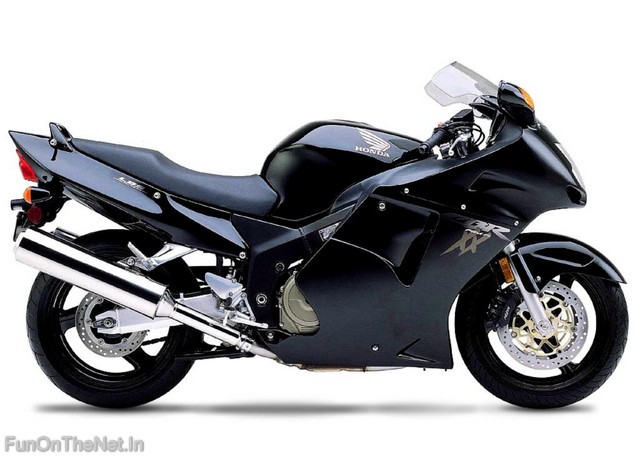
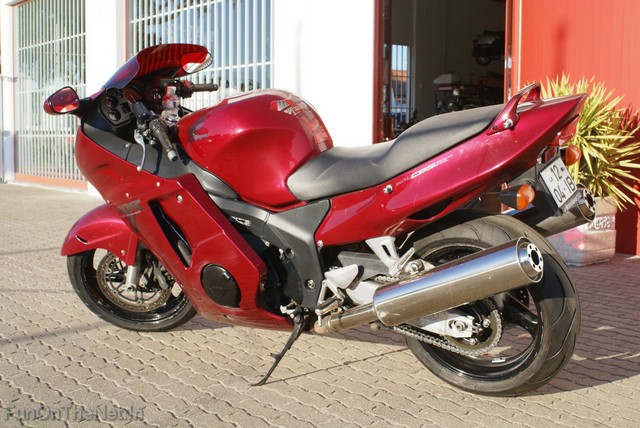
Yamaha YZF R1 176mph (283 km/h)

The Yamaha YZF-R1 motorcycle, introduced in 1998, was the first significant motorcycle in the true litre class (1,000 cc) "handling arms race" between the Japanese Big Four motorcycle manufacturers (Honda, Kawasaki, Suzuki and Yamaha). When introduced, it took the class closer to a true racing motorcycle, and increased the handling capabilities.
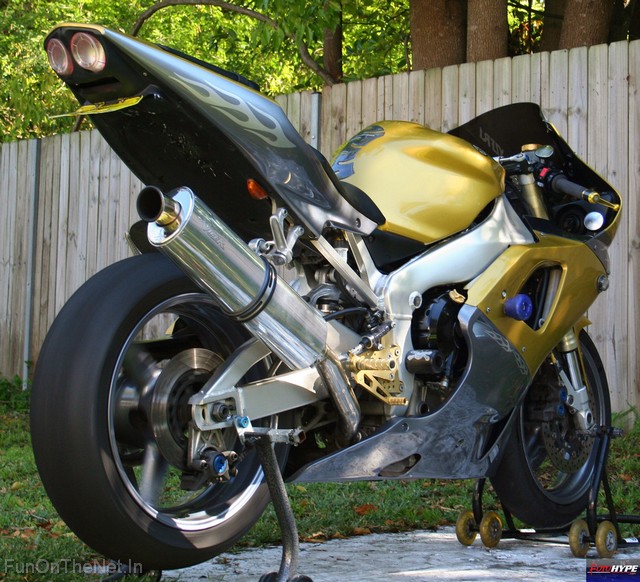

Aprilia RSV 1000R Mille 175mph (281 km/h)
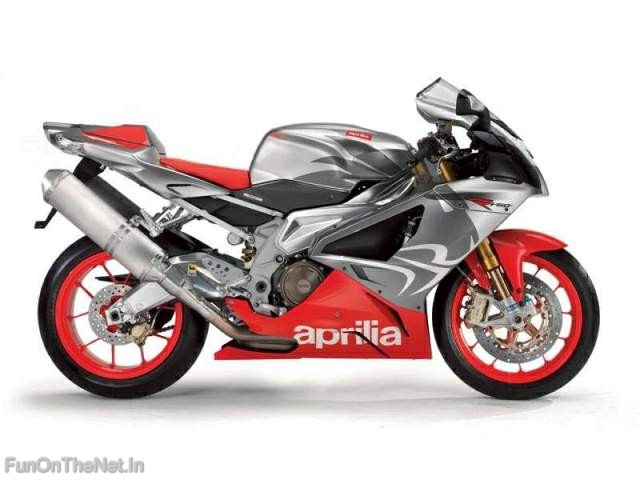
The RSV Mille and limited-edition RSV Mille Factory are high performance V-twin powered motorcycles made by Aprilia with a 143 HP 998 cc engine built by the Austrian company Rotax. For 2006. the RSV Mille Factory won the Maxisport category for Masterbike 2006 and overall Masterbike of the year.
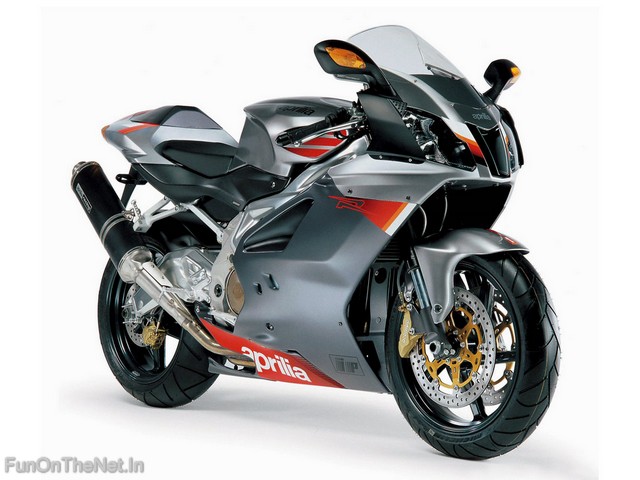
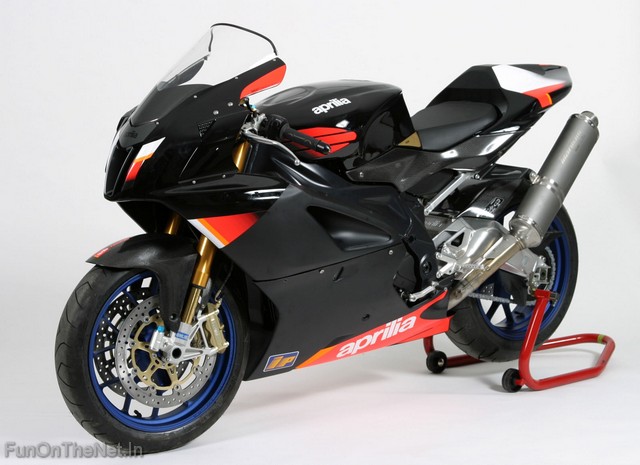
Ducati 1098s 169 mph (271 km/h)
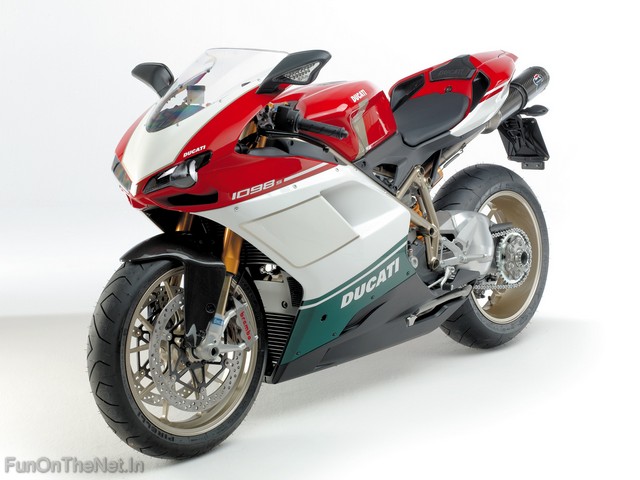
The Ducati 1098 is a 1099 cc L-twin sport bike manufactured by Ducati. It was announced on November 8, 2006 for the 2007 model year and replaces the 999. The 1098 makes a manufacturer claimed 160 horsepower, 90.4 ft-lb torque, and weighs 173kg. These figures gives the 1098 the highest torque-to-weight ratio of any production sport bike ever made.
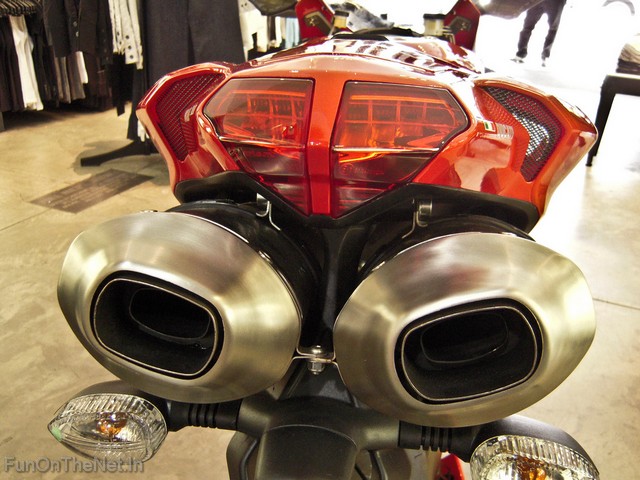

BMW K1200S 167 mhh (268 km/h)
With enough raw power to shock even the most seasoned adrenaline junky, the K 1200 S hurls you from a dead stop to sixty mph in just 2.8 seconds. Once you're over the whiplash, you'll keep climbing, topping out at speeds that run neck-and-neck with the fastest production motorcycles in the world.
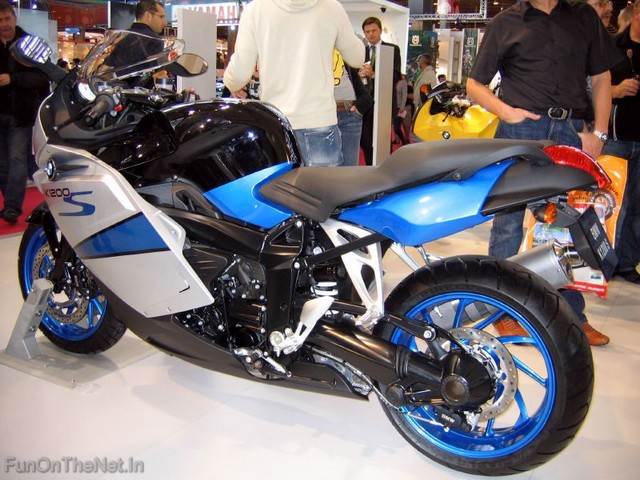
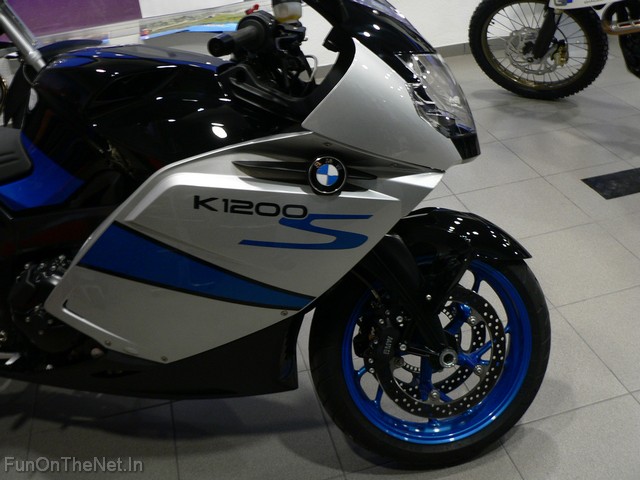
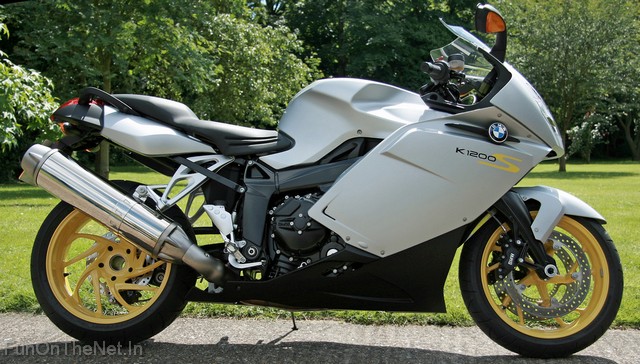
BMW R1200R
BMW R1200R
There was a time when I considered that on reaching 50, one’s life was over. Not any more. I used to think that anyone who rode a large naked BMW like an R80, R90 or R100 could be guaranteed to smell of urine, have a pipe and beard, and wear a set of Belstaffs covered in Ulysses and rally badges. Not any more.
World’s Most Expensive Motorcycles
Motorcycles have had mass appeal to the general public for roughly a century and a half. An American named Sylvester Howard Roper designed one of the first motorcycles in the 1860s. The motorcycle was displayed at fairs and circuses around the eastern U.S.. Europeans also had their hand in popularizing motorcycles and during the World Wars, motorcycles functioned as a quick means of transportation.
As the motorcycle progressed, the engines and frames became bigger, sleeker, faster and more powerful, resulting in the high-tech and expensive motorcycles of today. If you can afford one, a custom motorcycle built to your exact specifications is within reach.
Currently, the most expensive motorcycles in production are fetching in between $100,000 and $200,000 US. While researching expensive motorcycles, we found 4 bikes that dominate all others in performance, appearance…and cost.
The fourth most expensive motorcycle we found is the new MV Agusta F4 CC created by Claudio Castiglioni, the motorcycle company’s director. He wanted to create a spectacular motorcycle that met strategic marketing needs while also being something truly special and unique. The expensive motorcycle bearing his very own initials “CC” has a top speed of 315 kph (195 mph), 1078 cc’s and a 198 hp engine. Each bike will boast a platinum plate located near the top of the steering column showing the model number from 1 to 100, making this motorcycle all the more special to its owners. This Italian dream costs 100,000 Euros ($133,745US).
MV Agusta F4 CC
Next on our list is the MTT Turbine Superbike costing $150,000 (111,000 Euros). Not only is this motorcycle expensive, its also extremely fast. The Superbike is the Guinness World Record holder for the “Most Powerful Motorcycle Ever to Enter Series Production”. The turbine engine in this one is made by Rolls Royce and is capable of over 300hp. The motorcycle also boasts carbon fiber fairings, a rear mounted camera with LCD color display, forward-and rear-looking radar detector with laser scrambler, one touch “Smart Start” ignition, and many other cool gadgets. This bike seams to be pretty popular in Hollywood. It starred in the movie “Torque” and even Jay Leno owns one!
MTT Turbine Superbike
The Macchia Nera Concept Bike is near the top of the list of most expensive motorcycles at 150,000 Euros ($201,000). Built around a Ducati 998RS engine, its Italian designers and engineers set out to create an extremely high tech and expensive motorcycle that would be thought of as “the ultimate track bike” that is “simply beautiful and beautifully simple”. The Testastretta engine is fitted with lightweight metals and alloys like titanium and aluminum making it very lightweight. The view from the side of the Macchia Nera shows exposed belts and engine components, giving its design a minimalist feel while still being aesthetically pleasing. We should add that this bike is a one of a kind and not in produced for retail at this point, but if you have an extra 150,000 Euros ($201,000) laying around for an expensive toy, your dream might come true.
Macchia Nera Concept Bike
The most expensive motorcycle in production will cost you at least $250,000. The production is limited to a few hundred models, so you better place your order. The Dodge Tomahawk V10 superbike boasts 8.3 liter engine (505 cubic inch), and the 10 cylinders can bring the bike to a maximum speed of almost 400 mph. The 1500lb bike has an independent 4 wheel suspension and can reach 60 mph in around 2.5 seconds.
Dodge Tomahawk
BMW launch new Limited Edition R1200RT
BMW Motorrad has announced the release of a Limited Edition version of their R1200RT tourer.
Just 200 models will be available, all in sapphire black metallic colour. A matching black top box, ASC (Automatic Stability Control) and Tyre Pressure Control all come as part of the Limited Edition package as an enhancement to the current SE model specification. The R 1200 RT LE is now available in BMW Motorrad Dealerships priced at £12,495, which represents a £450 saving compared to specifying the £12,125 SE model with the three extra factory options detailed above.
The legendary R 1200 RT, renowned for being dynamically agile with a highly stable chassis, boasts outstanding power and comfort as well as exceptional fuel economy and range.
UK Specification of the R 1200 RT LE includes factory options:
· ESA (Electronic Suspension Adjustment)· Cruise Control
· ASC (Automatic Stability Control)
· Tyre Pressure Control
· Colour Coded Top Box
· On Board Computer
· Seat Heating
· Heated Grips
· Additional Power Socket
· White Indicator Lenses
· Chrome Exhaust






























0 Responses to Ducati and Yamaha Launching 3 New Bikes in 2011